China and Covid19
“Xi’an, What Are You Doing?!” – Lockdown Mismanagement Leaves Residents Angry and Scared
Quarantined Xi’an: “This outbreak is really putting the city’s management to the test.”
Published
3 years agoon

On the 11th day of strict lockdown in the city of Xi’an, many residents are struggling with food shortages and meeting basic needs. Others are emphasizing the rays of light in dark times.
For many living in the city of Xi’an, the New Year did not start off bright and joyful, but dark and filled with anxiousness.
On December 22, more than 13 million residents were ordered to stay at home and a strict lockdown began after the city saw a new wave of Covid19 infections, recording 143 infections in the two weeks before since December 9th.
December 28 marked a record high of 175 new confirmed cases in a single day. By December 29th, the number of recorded infections reached 1,117, going up to 1,444 on January 1st and 1,573 on January 2nd.
As the city entered its tenth day under strict lockdown this weekend, Weibo saw an outpouring of anger and disbelief from sleepless netizens who expressed their shock over the way in which local authorities were managing the Covid19 outbreak and the lockdown itself.
With most offline and takeout stores being closed and residents not allowed the leave their compounds, getting food supplies and other essentials became a serious problem for many.
Residents were initially allowed to have one person in their household go out to buy groceries, but rules were later tightened, not allowing residents to leave at all except for Covid19 testing.
Although many households soon received government supplies, there were also communities where no food had been delivered yet and where online groceries were delayed. Some on Weibo complained that they had already been eating instant noodles for eight days straight, unable to get any vegetables.
These were some of the hashtags and taglines on Weibo surrounding incidents sparking outrage.
Food Shortages in Xi’an #西安买菜难#
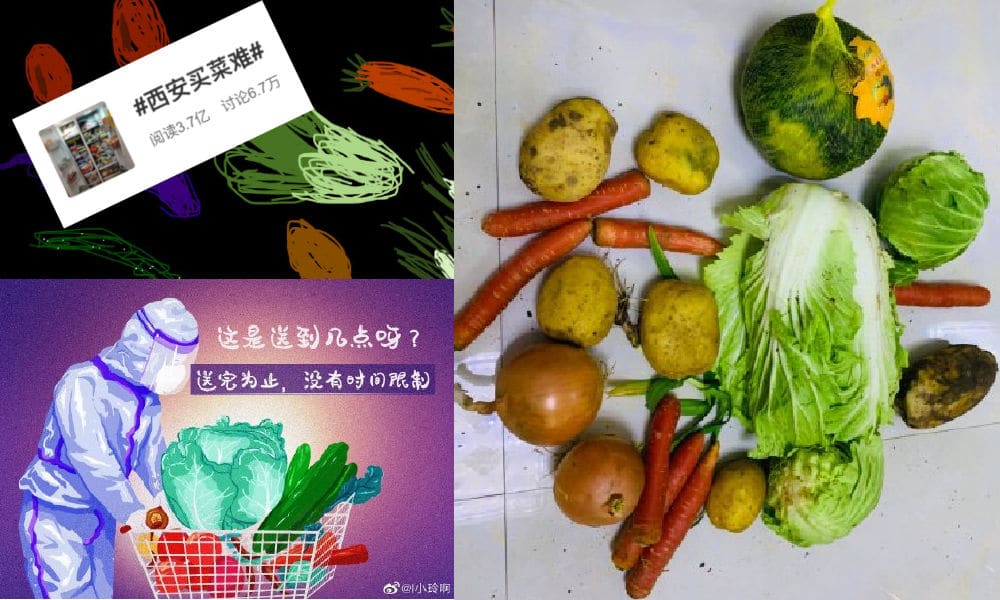
The hashtag “Difficult to Buy Food in Xi’an” (#西安买菜难#) had received over 370 million clicks by Sunday, January 2nd.
Many people are sharing their stories of saving up what they have left at home, not eating vegetables or fruit for over a week, and expressing their fear of going hungry and not having enough formula to feed their babies. Some also write about not being able to get much-needed medicine for family members with medical conditions such as cancer or diabetes.
“I’m a student who is stranded in Xi’an,” one young woman wrote: “I’m lucky that I rented a room for a month so I have a place to stay, but I’m worried about whether or not there is enough food to eat! In this phase of developing the New Era of Socialism with Chinese Characteristics, there are still people who are worried about not being able to eat.” She later adds: “I just have two packs of noodles left, preparing to delay eating them as long as I can and will only eat them when I am most hungry.”
Other people also expressed concerns over not being able to get other essentials, such as sanitary napkins and diapers: “Where can I buy diapers for my baby? I can’t get them offline, I can’t get them online, but this is also a basic necessity!”
While people are crying out for help over not being able to get food, there are also many videos on Weibo showing how local anti-epidemic workers are distributing food throughout the city.
As anti-epidemic workers are bringing food to local communities, videos such as these having been going viral on Weibo. pic.twitter.com/lWdidgXNmm
— Manya Koetse (@manyapan) January 1, 2022
Hundreds of netizens posted photos of the vegetable boxes they received from the government, expressing gratitude over the food and the volunteers who brought it to them. While some are creative in making dolls from their received vegetables, others are making drawings of the vegetables they wish they had.

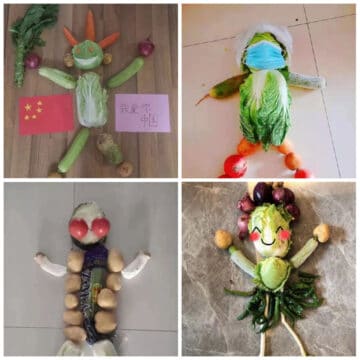
“I feel like I’m living in a parallel universe if I see the residents of Xi’an in the news,” one local Weibo user writes on January 2nd: “In Baqiao District (灞桥区) of Xi’an, the fact is that from the lockdown up to now, our neighborhood hasn’t seen a single grain of rice or vegetable from the government.”
People living in Shajing town (沙井村) also sent out messages online to share their struggles. One person posted a video showing a long line of people queuing up for steamed buns.
In light of Xi'an lockdown, some people in Shajing Village are really struggling. Endless lines for steamed buns, hungry people & those who've had nothing but noodles for 8 days straight: "When will we get food? Everyone in the house is hungry. We can only ask for help on Weibo." pic.twitter.com/CWxL2UDBxH
— Manya Koetse (@manyapan) January 1, 2022
“The landlord here in Shajing town received two cabbages, two carrots, and two potatoes, but the tenants didn’t get anything,” one Weibo user from the area wrote.
Man Gets Beaten Up for Buying Steamed Buns #西安小伙买馒头被群殴#
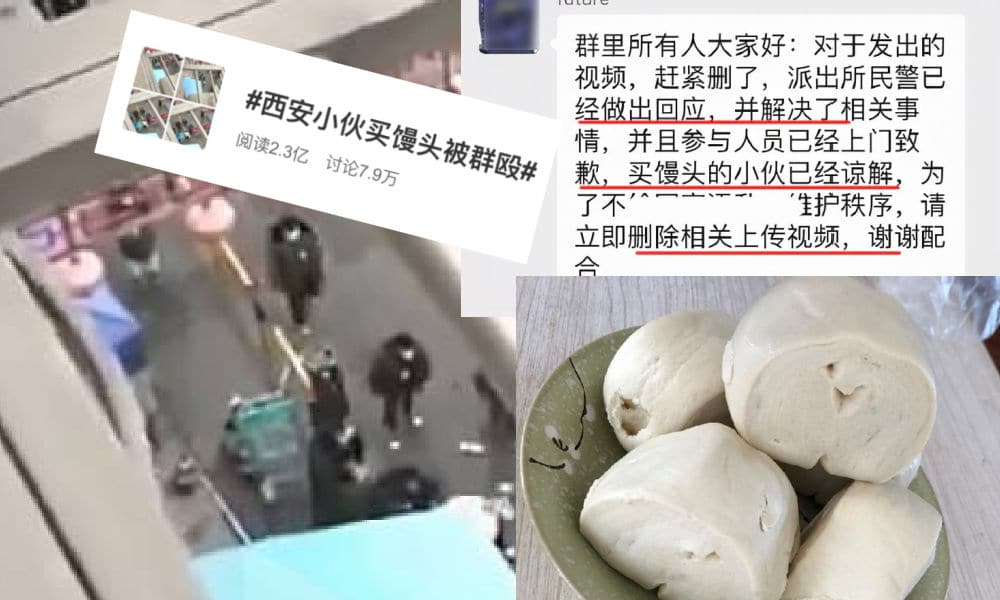
A video showing how one Xi’an resident got beaten up by two community guards upon return to his compound after buying food went viral on social media this week.
The hashtag “Xi’an Guy Gets Beaten Up Buying Mantou [Steamed Buns]” (#西安小伙买馒头被群殴#) received over 230 million views on Weibo. Other hashtags related to the incident received 330 million and 90 million views respectively (#西安通报2名防疫人员殴打市民#, #警方通报西安2名防疫人员殴打市民#)
The incident happened on December 31st around noon in the Yanta District of Xi’an. Social media users who posted a video of the incident said the man had left the compound to buy some buns because he was hungry.
But there was also this video of a resident being beaten by anti-epidemic workers after he allegedly left his community to get steamed buns because he was so hungry. The two community workers have reportedly been detained by Xi’an police. pic.twitter.com/lxHv6zl1gF
— Manya Koetse (@manyapan) January 1, 2022
The man can be seen standing at the gates of the compound talking to the guards when one of them approaches him from behind and seemingly grabs his phone. Another guard then physically attacks the man, with two other community workers also joining in punching the man, his food getting scattered on the floor.
It was later reported that the guards apologized for their actions. Local police also sent out a statement that, in accordance with the law, the two guards who punched the man will be detained for seven days and were each given a 200 yuan fine.
The video angered many people for various reasons, with some also understanding why social tensions are rising in local communities where people are unsure of when they’ll get food while the guards are also put in a tough job during such a strict lockdown.
Sudden Quarantine of Mingde Bayingli Community #西安明德八英里小区#
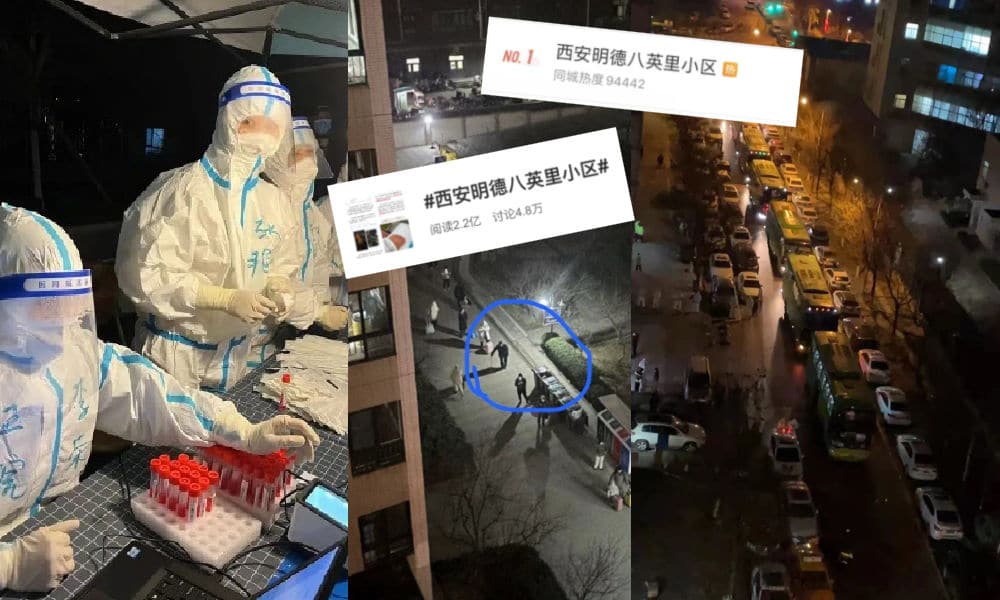
Another hashtag attracting major attention on Chinese social media was one concerning the Mingde 8 Yingli community (明德八英里小区) in Yanta District, where dozens of residents received news that they would be quarantined away from their compound together in the night of January 1st due to new infections in their proximity.
Residents complained on Weibo and WeChat that they were unsure of where they were heading, that they were put in buses together for hours until being driven off to a remote guest house without proper supplies. Old people, small children, and pregnant women were among those being taken away for quarantine without allegedly being provided with the things they needed, and without any measures to protect them against the dangers of infection.
Others wondered what the point of the isolation was. After all, these residents were already staying inside their homes since the 20th of December, besides going out for Covid19 tests. What was the point of taking them away together?
Many commenters were moved to tears when they saw an image of an old man standing in line for the quarantine. The man, holding a walking stick, was seemingly all alone and did not seem to have luggage or food supplies with him. People worried about his wellbeing.
One WeChat article titled “Xi’an, Is This How You Control the Virus?” (“西安,这就是你的防疫管控?”) criticized the way in which the situation was handled, but it was soon taken offline.
Still, many others on Weibo also wrote things such as: “Xi’an, what are you doing?”, expressing disbelief that the city seemingly was not prepared for a lockdown like this even though it has been two years since the pandemic started.
On January 2nd, Chinese media reported that two local Xi’an officials, Wang Bin (王斌) and Cui Shiyue (崔诗越), were removed from their positions in order to “strengthen the epidemic prevention and control efforts.”
“It’s begun now,” some commenters posted, suggesting that local authorities are turning things around to improve the situation in the city’s districts.
There are also many netizens praising the efforts of anti-epidemic staff who are working around the clock to get food to the various communities.
One viral video showed a woman breaking down in tears as she told a local health worker that she was on her period, but that there was no way for her to get sanitary pads.
“They also can’t help it,” one person responded: “This outbreak is really putting the city’s management to the test.”

“I started my first day as a volunteer today,” one Weibo user wrote: “It was very tiring, but it is cool that I am doing what I want to do. I know things are not perfect. But we’re trying.”
This volunteer health worker from a local art troupe played the patriotic "My People, My Country" (我和我的祖国) on New Year's Eve in Xi'an where the strict lockdown continues. Residents are cheering from their windows. pic.twitter.com/QqAh0L4MGb
— Manya Koetse (@manyapan) January 1, 2022
One volunteer health worker from a local art troupe played the patriotic “My People, My Country” (我和我的祖国) on New Year’s Eve while residents were cheering from their windows. On Weibo, the same sentiment was shared by many: “Come on Xi’an! A big thank you to all the frontline workers in the fight against the epidemic.”
Meanwhile, the cries for help also continue. “I really understand the hard work of the [anti-epidemic] staff,” one Xi’an citizen writes: “But our family will soon run out of food. We live in a tiny neighborhood – please don’t forget about us.”
By Manya Koetse
Spotted a mistake or want to add something? Please let us know in comments below or email us. First-time commenters, please be patient – we will have to manually approve your comment before it appears.
©2021 Whatsonweibo. All rights reserved. Do not reproduce our content without permission – you can contact us at info@whatsonweibo.com.
Manya Koetse is the founder and editor-in-chief of whatsonweibo.com. She is a writer, public speaker, and researcher (Sinologist, MPhil) on social trends, digital developments, and new media in an ever-changing China, with a focus on Chinese society, pop culture, and gender issues. She shares her love for hotpot on hotpotambassador.com. Contact at manya@whatsonweibo.com, or follow on Twitter.

Also Read
China and Covid19
Sick Kids, Worried Parents, Overcrowded Hospitals: China’s Peak Flu Season on the Way
“Besides Mycoplasma infections, cases include influenza, Covid-19, Norovirus, and Adenovirus. Heading straight to the hospital could mean entering a cesspool of viruses.”
Published
8 months agoon
November 22, 2023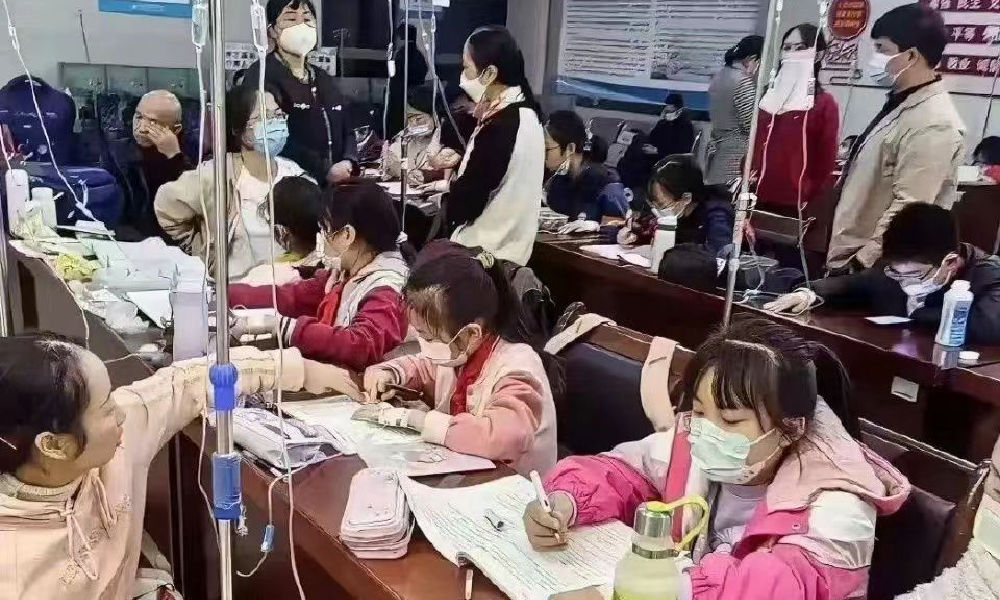
In the early morning of November 21, parents are already queuing up at Xi’an Children’s Hospital with their sons and daughters. It’s not even the line for a doctor’s appointment, but rather for the removal of IV needles.
The scene was captured in a recent video, only one among many videos and images that have been making their rounds on Chinese social media these days (#凌晨的儿童医院拔针也要排队#).
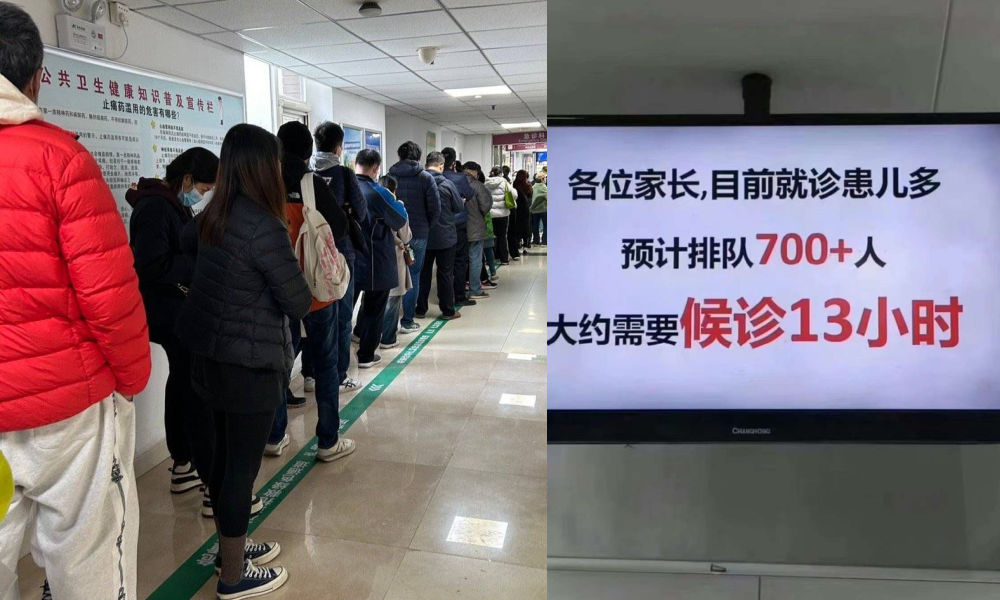
One photo shows a bulletin board at a local hospital warning parents that over 700 patients are waiting in line, estimating a waiting time of more than 13 hours to see a doctor.
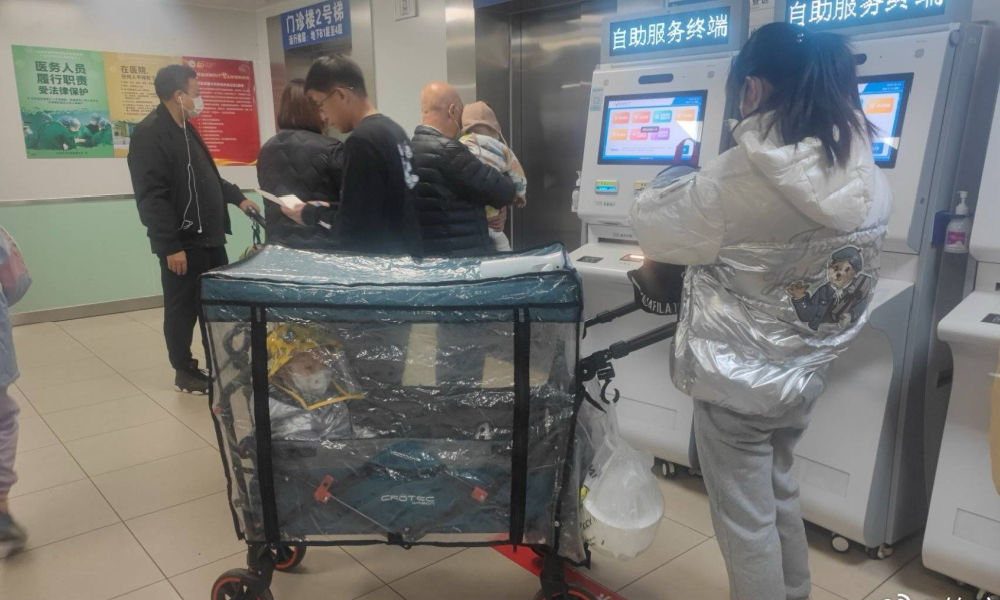
Another image shows children doing their homework while hooked up on an IV.

Recent discussions on Chinese social media platforms have highlighted a notable surge in flu cases. The ongoing flu season is particularly impacting children, with multiple viruses concurrently circulating and contributing to a high incidence of respiratory infections.
Among the prevalent respiratory infections affecting children are Mycoplasma pneumoniae infections, influenza, and Adenovirus infection.
The spike in flu cases has resulted in overcrowded children’s hospitals in Beijing and other Chinese cities. Parents sometimes have to wait in line for hours to get an appointment or pick up medication.
According to one reporter at Haibao News (海报新闻), there were so many patients at the Children’s Hospital of Capital Institute of Pediatrics (首都儿科研究所) on November 21st that the outpatient desk stopped accepting new patients by the afternoon. Meanwhile, 628 people were waiting in line to see a doctor at the emergency department.
Reflecting on the past few years, the current flu season marks China’s first ‘normal’ flu peak season since the outbreak of Covid-19 in late 2019 / early 2020 and the end of its stringent zero-Covid policies in December 2022. Compared to many other countries, wearing masks was also commonplace for much longer following the relaxation of Covid policies.
Hu Xijin, the well-known political commentator, noted on Weibo that this year’s flu season seems to be far worse than that of the years before. He also shared that his own granddaughter was suffering from a 40 degrees fever.
“We’re all running a fever in our home. But I didn’t dare to go to the hospital today, although I want my child to go to the hospital tomorrow. I heard waiting times are up to five hours now,” one Weibo user wrote.
“Half of the kids in my child’s class are sick now. The hospital is overflowing with people,” another person commented.
One mother described how her 7-year-old child had been running a fever for eight days already. Seeking medical attention on the first day, the initial diagnosis was a cold. As the fever persisted, daily visits to the hospital ensued, involving multiple hours for IV fluid administration.
While this account stems from a single Weibo post within a fever-advice community, it highlights a broader trend: many parents swiftly resort to hospital visits at the first signs of flu or fever. Several factors contribute to this, including a lack of General Practitioners in China, making hospitals the primary choice for medical consultations also in non-urgent cases.
There is also a strong belief in the efficacy of IV infusion therapy, whether fluid-based or containing medication, as the quickest path to recovery. Multiple factors contribute to the widespread and sometimes irrational use of IV infusions in China. Some clinics are profit-driven and see IV infusions as a way to make more money. Widespread expectations among Chinese patients that IV infusions will make them feel better also play a role, along with some physicians’ lacking knowledge of IV therapy or their uncertainty to distinguish bacterial from viral infections (read more here)
To prevent an overwhelming influx of patients to hospitals, Chinese state media, citing specialists, advise parents to seek medical attention at the hospital only for sick infants under three months old displaying clear signs of fever (with or without cough). For older children, it is recommended to consult a doctor if a high fever persists for 3 to 5 days or if there is a deterioration in respiratory symptoms. Children dealing with fever and (mild) respiratory symptoms can otherwise recover at home.
One Weibo blogger (@奶霸知道) warned parents that taking their child straight to the hospital on the first day of them getting sick could actually be a bad idea. They write:
“(..) pediatric departments are already packed with patients, and it’s not just Mycoplasma infections anymore. Cases include influenza, Covid-19, Norovirus, and Adenovirus. And then, of course, those with bad luck are cross-infected with multiple viruses at the same time, leading to endless cycles. Therefore, if your child experiences mild coughing or a slight fever, consider observing at home first. Heading straight to the hospital could mean entering a cesspool of viruses.”
The hashtag for “fever” saw over 350 million clicks on Weibo within one day on November 22.
Meanwhile, there are also other ongoing discussions on Weibo surrounding the current flu season. One topic revolves around whether children should continue doing their homework while receiving IV fluids in the hospital. Some hospitals have designated special desks and study areas for children.
Although some commenters commend the hospitals for being so considerate, others also remind the parents not to pressure their kids too much and to let them rest when they are not feeling well.
Opinions vary: although some on Chinese social media say it's very thoughtful for hospitals to set up areas where kids can study and read, others blame parents for pressuring their kids to do homework at the hospital instead of resting when not feeling well. pic.twitter.com/gnQD9tFW2c
— Manya Koetse (@manyapan) November 22, 2023
By Manya Koetse, with contributions from Miranda Barnes
Get the story behind the hashtag. Subscribe to What’s on Weibo here to receive our newsletter and get access to our latest articles:
Spotted a mistake or want to add something? Please let us know in comments below or email us. First-time commenters, please be patient – we will have to manually approve your comment before it appears.
©2023 Whatsonweibo. All rights reserved. Do not reproduce our content without permission – you can contact us at info@whatsonweibo.com.
China and Covid19
Repurposing China’s Abandoned Nucleic Acid Booths: 10 Innovative Transformations
Abandoned nucleic acid booths are getting a second life through these new initiatives.
Published
1 year agoon
May 19, 2023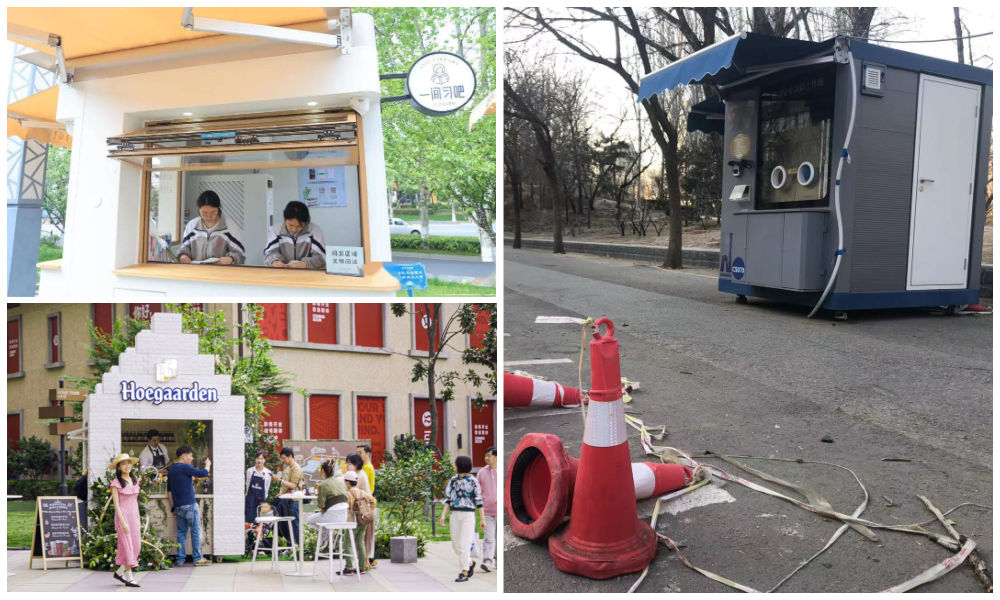
During the pandemic, nucleic acid testing booths in Chinese cities were primarily focused on maintaining physical distance. Now, empty booths are being repurposed to bring people together, serving as new spaces to serve the community and promote social engagement.
Just months ago, nucleic acid testing booths were the most lively spots of some Chinese cities. During the 2022 Shanghai summer, for example, there were massive queues in front of the city’s nucleic acid booths, as people needed a negative PCR test no older than 72 hours for accessing public transport, going to work, or visiting markets and malls.
The word ‘hésuān tíng‘ (核酸亭), nucleic acid booth (also:核酸采样小屋), became a part of China’s pandemic lexicon, just like hésuān dìtú (核酸地图), the nucleic acid test map lauched in May 2022 that would show where you can get a nucleic test.
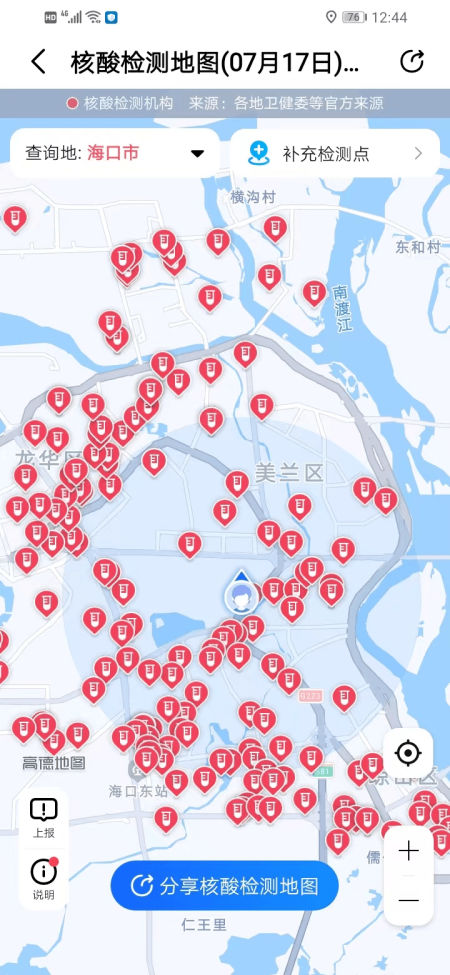
Example of nucleic acid test map.
During Halloween parties in Shanghai in 2022, some people even came dressed up as nucleic test booths – although local authorities could not appreciate the creative costume.
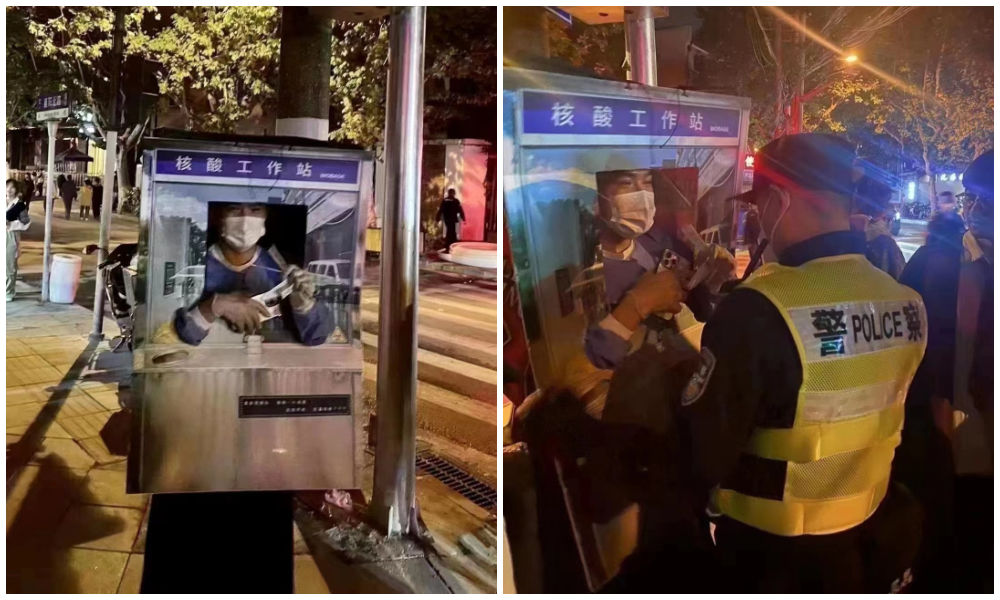
Halloween 2022: dressed up as nucliec acid booths. Via @manyapan twitter.
In December 2022, along with the announced changed rules in China’s ‘zero Covid’ approach, nucleic acid booths were suddenly left dismantled and empty.
With many cities spending millions to set up these booths in central locations, the question soon arose: what should they do with the abandoned booths?
This question also relates to who actually owns them, since the ownership is mixed. Some booths were purchased by authorities, others were bought by companies, and there are also local communities owning their own testing booths. Depending on the contracts and legal implications, not all booths are able to get a new function or be removed yet (Worker’s Daily).
In Tianjin, a total of 266 nucleic acid booths located in Jinghai District were listed for public acquisition earlier this month, and they were acquired for 4.78 million yuan (US$683.300) by a local food and beverage company which will transform the booths into convenience service points, selling snacks or providing other services.
Tianjin is not the only city where old nucleic acid testing booths are being repurposed. While some booths have been discarded, some companies and/or local governments – in cooperation with local communities – have demonstrated creativity by transforming the booths into new landmarks. Since the start of 2023, different cities and districts across China have already begun to repurpose testing booths. Here, we will explore ten different way in which China’s abandoned nucleic test booths get a second chance at a meaningful existence.
1: Pharmacy/Medical Booths
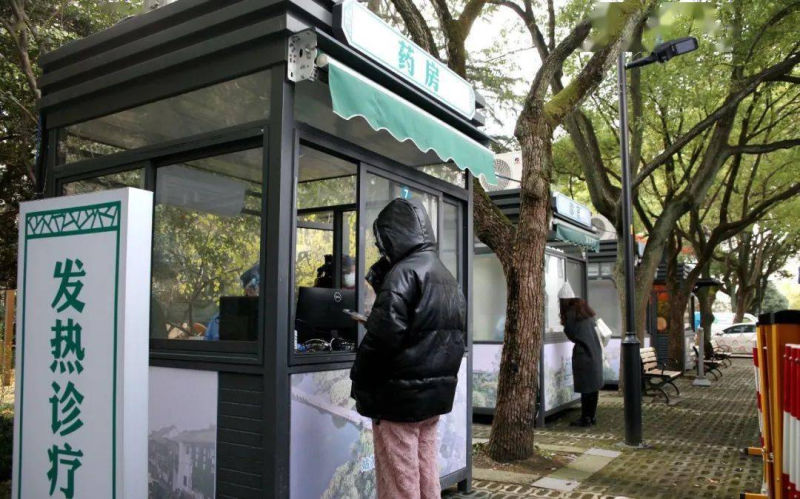
Via ‘copyquan’ republished on Sohu.
Blogger ‘copyquan’ recently explored various ways in which abandoned PCR testing points are being repurposed.
One way in which they are used is as small pharmacies or as medical service points for local residents (居民医疗点). Alleviating the strain on hospitals and pharmacies, this was one of the earliest ways in which the booths were repurposed back in December of 2022 and January of 2023.
Chongqing, Tianjin, and Suzhou were among earlier cities where some testing booths were transformed into convenient medical facilities.
2: Market Stalls
In Suzhou, Jiangsu province, the local government transformed vacant nucleic acid booths into market stalls for the Spring Festival in January 2022, offering them free of charge to businesses to sell local products, snacks, and traditional New Year goods.
The idea was not just meant as a way for small businesses to conveniently sell to local residents, it was also meant as a way to attract more shoppers and promote other businesses in the neighborhood.
3: Community Service Center

Small grid community center in Shizhuang Village, image via Sohu.
Some residential areas have transformed their local nucleic acid testing booths into community service centers, offering all kinds of convenient services to neighborhood residents.
These little station are called wǎnggé yìzhàn (网格驿站) or “grid service stations,” and they can serve as small community centers where residents can get various kinds of care and support.
4: “Refuel” Stations
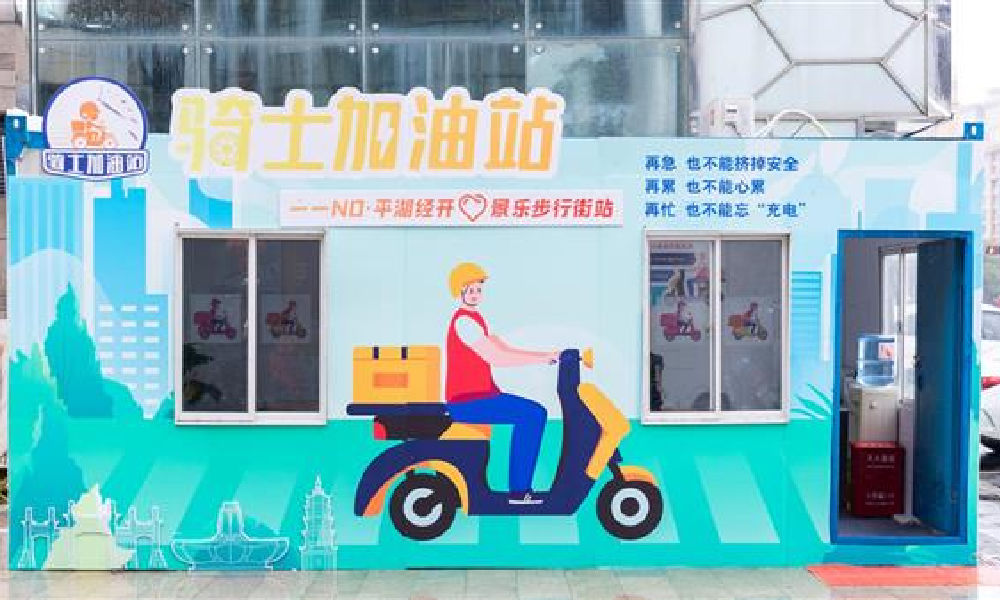
In February of this year, 100 idle nucleic acid sampling booths were transformed into so-called “Rider Refuel Stations” (骑士加油站) in Zhejiang’s Pinghu. Although it initially sounds like a place where delivery riders can fill up their fuel tanks, it is actually meant as a place where they themselves can recharge.
Delivery riders and other outdoor workers can come to the ‘refuel’ station to drink some water or tea, warm their hands, warm up some food and take a quick nap.
5: Free Libraries
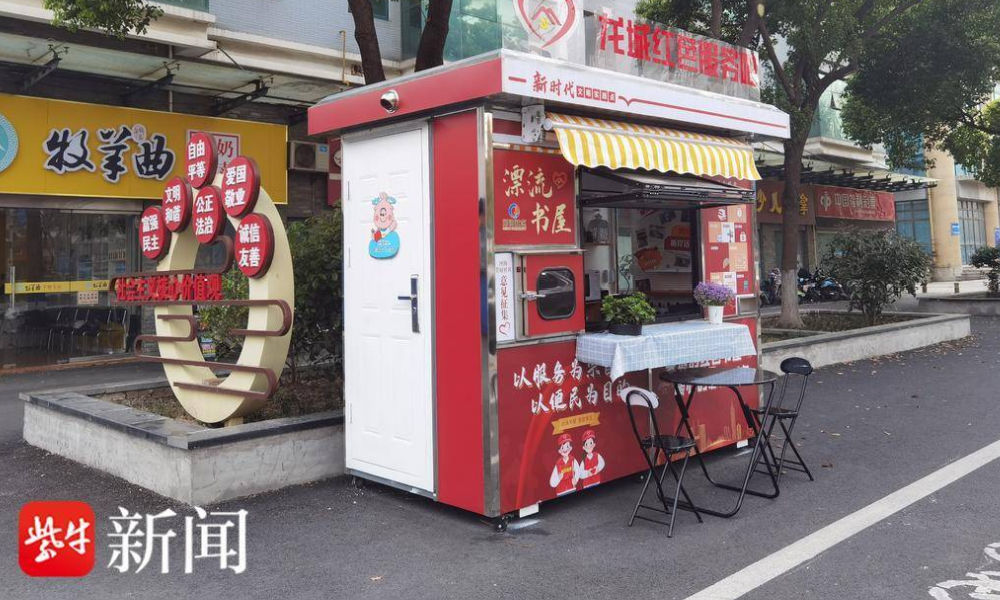
image via sohu.
In various Chinese cities, abandoned nucleic acid booths have been transformed into little free libraries where people can grab some books to read, donate or return other books, and sit down for some reading.
Changzhou is one of the places where you’ll find such “drifting bookstores” (漂流书屋) (see video), but similar initiatives have also been launched in other places, including Suzhou.
6: Study Space
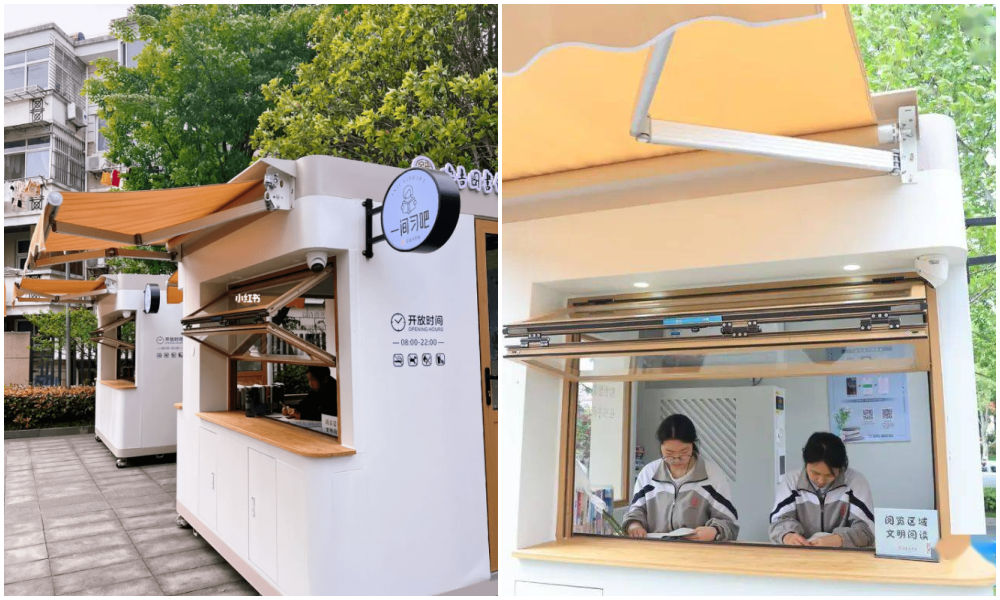
Photos via Copyquan’s article on Sohu.
Another innovative way in which old testing points are being repurposed is by turning them into places where students can sit together to study. The so-called “Let’s Study Space” (一间习吧), fully airconditioned, are opened from 8 in the morning until 22:00 at night.
Students – or any citizens who would like a nice place to study – can make online reservations with their ID cards and scan a QR code to enter the study rooms.
There are currently ten study booths in Anji, and the popular project is an initiative by the Anji County Library in Zhejiang (see video).
7: Beer Kiosk
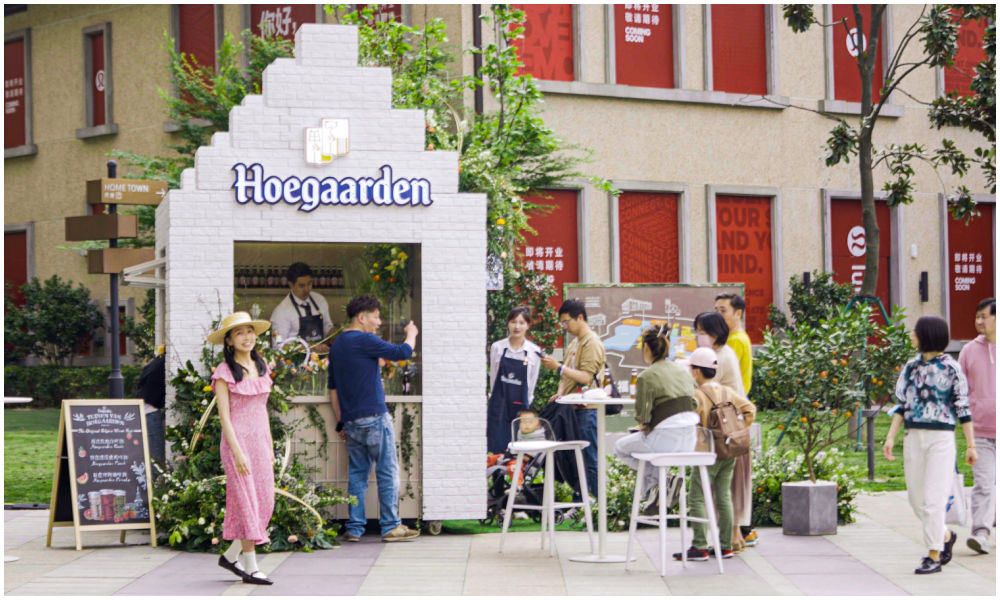
Hoegaarden beer shop, image via Creative Adquan.
Changing an old nucleic acid testing booth into a beer bar is a marketing initiative by the Shanghai McCann ad agency for the Belgium beer brand Hoegaarden.
The idea behind the bar is to celebrate a new spring after the pandemic. The ad agency has revamped a total of six formr nucleic acid booths into small Hoegaarden ‘beer gardens.’
8: Police Box
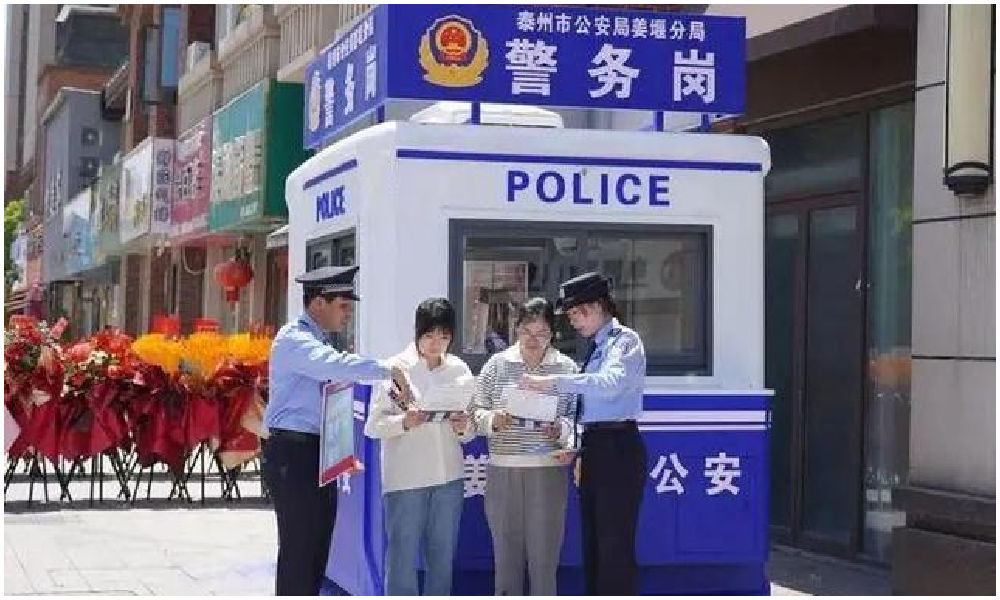
In Taizhou City, Jiangsu Province, authorities have repurposed old testing booths and transformed them into ‘police boxes’ (警务岗亭) to enhance security and improve the visibility of city police among the public.
Currently, a total of eight vacant nucleic acid booths have been renovated into modern police stations, serving as key points for police presence and interaction with the community.
9: Lottery Ticket Booths
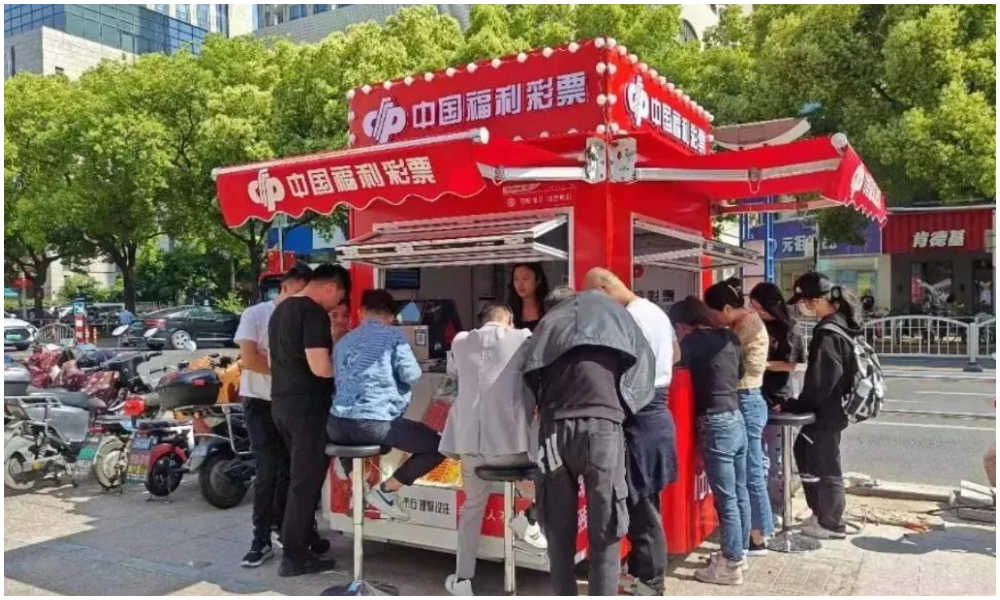
Image via The Paper
Some nucleic acid booths have now been turned into small shops selling lottery tickets for the China Welfare Lottery. One such place turning the kiosks into lottery shops is Songjiang in Shanghai.
Using the booths like this is a win-win situation: they are placed in central locations so it is more convenient for locals to get their lottery tickets, and on the other hand, the sales also help the community, as the profits are used for welfare projects, including care for the elderly.
10: Mini Fire Stations
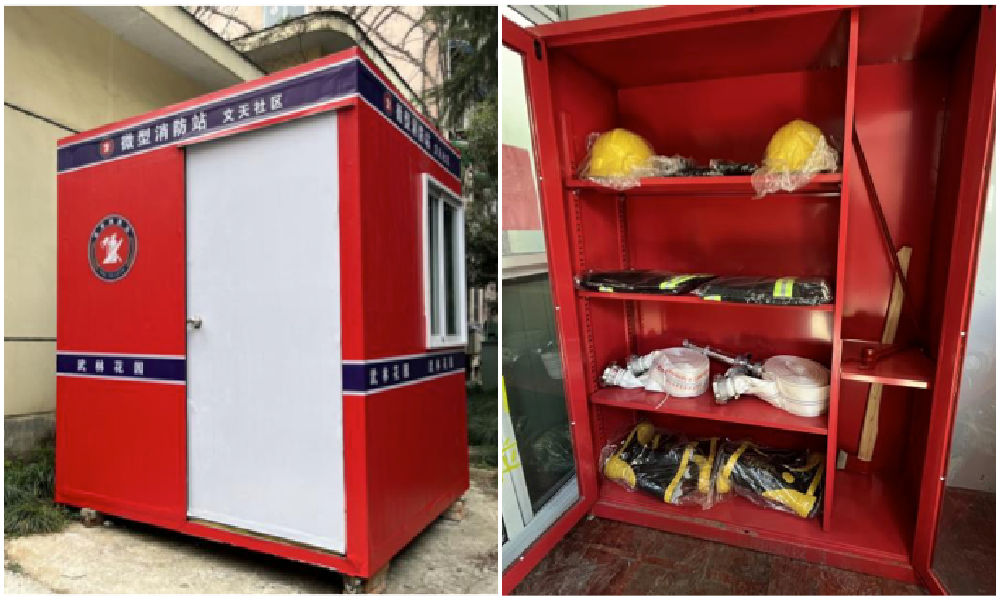
Micro fire stations, images via ZjNews.
Some communities decided that it would be useful to repurpose the testing points and turn them into mini fire kiosks, just allowing enough space for the necessary equipment to quickly respond to fire emergencies.
Want to read more about the end of ‘zero Covid’ in China? Check our other articles here.
By Manya Koetse,
Get the story behind the hashtag. Subscribe to What’s on Weibo here to receive our newsletter and get access to our latest articles:
Spotted a mistake or want to add something? Please let us know in comments below or email us. First-time commenters, please be patient – we will have to manually approve your comment before it appears.
©2023 Whatsonweibo. All rights reserved. Do not reproduce our content without permission – you can contact us at info@whatsonweibo.com.
Subscribe

Weibo Watch: The Future is Here

“Bye Bye Biden”: Biden’s Many Nicknames in Chinese

Enjoying the ‘Sea’ in Beijing’s Ditan Park

A Triumph for “Comrade Trump”: Chinese Social Media Reactions to Trump Rally Shooting

Weibo Watch: Get Up, Stand Up

The Tragic Story of “Fat Cat”: How a Chinese Gamer’s Suicide Went Viral

“Old Bull Eating Young Grass”: 86-Year-Old Chinese Painter Fan Zeng Marries 36-Year-Old Xu Meng

A Brew of Controversy: Lu Xun and LELECHA’s ‘Smoky’ Oolong Tea

Singing Competition or Patriotic Fight? Hunan TV’s ‘Singer 2024’ Stirs Nationalistic Sentiments

Zara Dress Goes Viral in China for Resemblance to Haidilao Apron

Weibo Watch: The Battle for the Bottom Bed

About the “AI Chatbot Based on Xi Jinping” Story

China’s Intensified Social Media Propaganda: “Taiwan Must Return to Motherland”

Weibo Watch: Telling China’s Stories Wrong

Saying Goodbye to “Uncle Wang”: Wang Wenbin Becomes Chinese Ambassador to Cambodia
Get in touch
Would you like to become a contributor, or do you have any tips or suggestions? Get in touch here!
Popular Reads
-

 China Insight3 months ago
China Insight3 months agoThe Tragic Story of “Fat Cat”: How a Chinese Gamer’s Suicide Went Viral
-

 China Music4 months ago
China Music4 months agoThe Chinese Viral TikTok Song Explained (No, It’s Not About Samsung)
-

 China Digital10 months ago
China Digital10 months agoToo Sexy for Weibo? Online Discussions on the Concept of ‘Cābiān’
-

 China Arts & Entertainment12 months ago
China Arts & Entertainment12 months agoBehind 8 Billion Streams: Who is Dao Lang Cursing in the Chinese Hit Song ‘Luocha Kingdom’?





